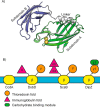Stress control for a well-structured life
- PMID: 29678889
- PMCID: PMC5912477
- DOI: 10.1074/jbc.H118.002699
Stress control for a well-structured life
Abstract
Aerobic life brings with it a need to respond to external redox stress in ways that preserve key processes.
© 2018 Goldstone and Baker.
Conflict of interest statement
The authors declare that they have no conflicts of interest with the contents of this article.
Figures

Similar articles
-
Disulfide isomerase activity of the dynamic, trimeric Proteus mirabilis ScsC protein is primed by the tandem immunoglobulin-fold domain of ScsB.J Biol Chem. 2018 Apr 20;293(16):5793-5805. doi: 10.1074/jbc.RA118.001860. Epub 2018 Feb 28. J Biol Chem. 2018. PMID: 29491145 Free PMC article.
-
Highly efficient folding of multi-disulfide proteins in superoxidizing Escherichia coli cytoplasm.Biotechnol Bioeng. 2014 Dec;111(12):2520-7. doi: 10.1002/bit.25309. Epub 2014 Aug 5. Biotechnol Bioeng. 2014. PMID: 24917025
-
Expression, purification and characterization of the suppressor of copper sensitivity (Scs) B membrane protein from Proteus mirabilis.Protein Expr Purif. 2022 May;193:106047. doi: 10.1016/j.pep.2022.106047. Epub 2022 Jan 11. Protein Expr Purif. 2022. PMID: 35026386
-
Protein disulfides and protein disulfide oxidoreductases in hyperthermophiles.FEBS J. 2006 Sep;273(18):4170-85. doi: 10.1111/j.1742-4658.2006.05421.x. Epub 2006 Aug 23. FEBS J. 2006. PMID: 16930136 Review.
-
Roles of thiol-redox pathways in bacteria.Annu Rev Microbiol. 2001;55:21-48. doi: 10.1146/annurev.micro.55.1.21. Annu Rev Microbiol. 2001. PMID: 11544348 Review.
References
-
- Cho S.-H., Parsonage D., Thurston C., Dutton R. J., Poole L. B., Collet J.-F., and Beckwith J. (2012) A new family of membrane electron transporters and its substrates, including a new cell envelope peroxiredoxin, reveal a broadened reductive capacity of the oxidative bacterial cell envelope. mBio 3, e00291–11 10.3391/mbi.2012.3.1.01 - DOI - PMC - PubMed
-
- Shepherd M., Heras B., Achard M. E., King G. J., Argente M. P., Kurth F., Taylor S. L., Howard M. J., King N. P., Schembri M. A., and McEwan A. G. (2013) Structural and functional characterization of ScsC, a periplasmic thioredoxin-like protein from Salmonella enterica serovar Typhimurium. Antioxid. Redox Signal. 19, 1494–1506 10.1089/ars.2012.4939 - DOI - PMC - PubMed
-
- Furlong E. J., Lo A. W., Kurth F., Premkumar L., Totsika M., Achard M. E. S., Halili M. A., Heras B., Whitten A. E., Choudhury H. G., Schembri M. A., and Martin J. L. (2017) A shape-shifting redox foldase contributes to Proteus mirabilis copper resistance. Nat. Commun. 8, 16065 10.1038/ncomms16065 - DOI - PMC - PubMed
MeSH terms
Substances
LinkOut - more resources
Full Text Sources
Other Literature Sources

